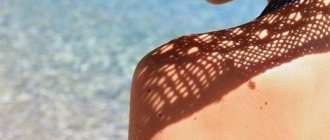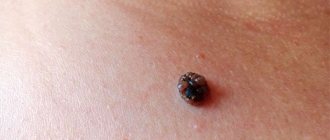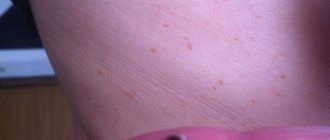Many people have dark-colored spots of varying sizes on their bodies. We are talking about moles or nevus.
Neoplasms are often benign in nature, formed as a result of the accelerated proliferation of pigment cell structures of the epidermis. Typically, a dark-colored pigmented nevus has an even structure with clear outlines. Although birthmarks can appear at any age, after the age of 30 this phenomenon occurs much less frequently. Many people are interested in whether black moles are dangerous, what to do if dark spots are found on the body? To answer these questions, you should carefully study the nature of the neoplasms and the possible causes of the appearance of the nevus.
Provoking factors
Moles that appear on the body are called nevi in medicine. They can be on the skin from birth or occur throughout life. The formations consist of melanocytes - pigmented cells of the epidermis. Most often the spots are brown in color. Nevi can darken in the following cases:
- Hormonal imbalance, especially during puberty and pregnancy. A child’s black mole may begin to enlarge and darken at the age of 12–17 years.
- Ultraviolet radiation.
- Regular damage to certain areas of the skin.
- Hereditary predisposition.
- Past illnesses caused by viruses or bacteria entering the body.
- Radiation, X-rays.
People over 35 years of age are most susceptible to malignancy of birthmarks, on whose skin new dark nevi have formed. Also at risk are patients with weakened immune systems and fair skin and hair.
People who have more than 50 spots on their body need to be especially careful about their health. Black moles on the back can be photographed with the help of relatives to monitor the condition of the skin.
Why
Sometimes a situation arises when black dots appear on the nevus. The causes of the pathology are simple.
- Prolonged exposure to sunlight has a detrimental effect on human skin, especially for Caucasian people. Ultraviolet irradiation causes darkening of parts of the tumor due to the accumulation of melanin. This is a protective reaction of the body.
- Frequent visits to the solarium and prolonged sessions pose a danger. As a result, lovers of artificial tanning receive a loading dose of ultraviolet radiation. As a result, pathology occurs.
- Accidental injury to the nevus: cut, burn, blow, also causes darkening of individual areas. Most often this goes away without a trace, but there are cases when the formation degenerates into melanoma - a cancerous tumor that requires surgical intervention. In addition to damage, heredity also plays a role.
The danger of black nevi
A birthmark is a benign neoplasm. They are divided into several types:
- Flat is the most common type. A red rim formed around the spot indicates the beginning of the pathological process.
- Convex - a growth protruding above the surface of the skin must be carefully observed, so that even with minor changes, consult a specialist for advice.
- Red-black - heterogeneous coloring of the nevus may be a normal variant. It can be nodular, flat, star-shaped or lump-shaped. You need to ensure that the color of the mole does not change.
- Hanging - a darkened, hanging formation indicates cell death.
A black birthmark is not dangerous if its diameter does not exceed 0.5 cm. The edges of the growth should be clear and the surface smooth. The following pathologies require treatment:
- Dysplastic nevus. A flat mole is more than 5 mm in diameter, with unclear outlines and a raised center.
- Melanoma is a birthmark with a changed structure. This growth is considered a form of cancer and is characterized by rapid development. Melanoma resembles a colorless or dark nodule with light, reddish or blue spots. Provided timely diagnosis and treatment, the prognosis is favorable.
Are pearl inclusions dangerous?
A flat mole with a dot inside can have pearly inclusions for various reasons. It will not be possible to determine the nature of the growth on your own. To find out the etiology of education, it is better to seek help from a specialist.
We recommend reading
- Reasons for the appearance of growths on a mole
- Do I need to take tests to remove a mole?
- Methods for safe removal of moles after childbirth
Symptoms of degeneration are considered to be a combination of inclusions with:
- Irregular shape.
- Blurred contours.
- Lumpy, heterogeneous surface.
- The appearance of a white or red rim around the growth.
- Constant itching, burning, pain.
- Intensive growth of the tumor (over several months the diameter of the growth has increased by more than 5-6 cm).
- The appearance of daughter nodules around the nevus.
- Long hair began to grow or, on the contrary, fall out.
- A dark/light dot has appeared on a flat mole.
- There is peeling and ulceration of the growth.
- A clear, green, yellow liquid is released from the nevus.
- Blood streaks are visible on the surface. Moles with inclusions periodically bleed.
- The inside of the nevus began to darken.
The listed symptoms help to suspect the disease. An experienced specialist will be able to deal with the problem in detail.
Possible complications
If a black mole appears on a leg, arm, chest or other part of the body, this does not always indicate the presence of health problems. But changes in education should make us wary.
Black hanging nevi often fall off without outside help, so patients do not always see a doctor. It must be remembered that the development of a malignant tumor can occur even after the disappearance of a small mole. The specialist carefully removes the dried formation before its natural separation and performs a histological analysis to identify atypical cells.
An itchy dark crust on a mole may indicate its degeneration. A brown crust usually appears after mechanical damage to the epidermis, while a black crust indicates a thermal burn. An unchanged nevus may itch for several reasons:
- External irritation - if the formation is rubbed by the seams of clothes, it is enough to reconsider your wardrobe.
- Cell division during active growth of a mole. It is necessary to exclude the development of oncology.
Diagnostic methods
If new spots appear on the body or the appearance of existing nevi has changed, you should contact a specialist to clarify the cause of the appearance of black moles on the body. Skin tumors are examined using the following methods:
- Survey. The doctor may be interested in how often the patient is exposed to direct sunlight, whether there is a hereditary predisposition to the formation of malignant tumors, or whether there is discomfort in the affected area.
- Laboratory examination of the composition of urine and blood.
- Dermatoscopy is an examination of the epidermis through a magnifying glass.
- Histology - detection of malignant cells.
- Analysis for the presence of tumor markers.
- Biopsy is the removal of nevus tissue for study.
Principles of therapy
A specialist may recommend removing benign formations only if there is a risk of injury from shoes or clothing. Nevi are operated on:
- larger than 10 mm;
- fast growing;
- with a glossy surface;
- asymmetrical, changing shape and color;
- lost hair follicles;
- covered with nodules;
- bleeding.
If, based on the diagnostic results, it has been established that a black mole poses a danger to the patient’s health, it must be removed.
Removal is carried out using the following methods:
- cryodestruction - freezing of formations with liquid nitrogen;
- laser burning of tissues;
- non-contact excision with a radio knife;
- electrocoagulation - cauterization of nevi with electric current;
- removal by traditional surgical method - used exclusively for malignant tumors.
After surgery, a small wound remains on the skin. To speed up its healing and avoid infection, it is necessary to regularly treat the damaged area with chlorhexidine or hydrogen peroxide. When the wound heals, it can be lubricated with Contractubex, which prevents the formation of a scar.
In what cases should a mole be removed?
The question of removing a nevus can only be decided by a specialist. The exception is when the growth is localized in a visible area of the body, which spoils the aesthetic appearance. If a person discovers one or more alarming signs, he should immediately visit a dermatologist. Namely:
- the size has changed up or down;
- itching and pain appeared;
- the edges have acquired a fuzzy outline;
- the nevus is swollen;
- the area around it is red and bleeding;
- the surface of the formation began to peel off.
Self-removal can have dangerous consequences for human health and life. Modern medicine can provide several methods for removing a mole. These methods include:
- Laser removal. The use of laser is painless and does not pose any danger. After the procedure there will be no scar or scar, so the procedure has many positive reviews.
- Cryodestruction. This method involves the impact of liquid nitrogen on the site of inflammation. The growth cells are completely destroyed.
- Electrocoagulation. High-frequency electric current is used as a destructive factor.
- Exposure to radio waves. Refers to a gentle method. As a result of exposure to radio waves, benign cells are destroyed.
After performing one of the listed procedures, the doctor will give recommendations on wound care. He will also advise you on how to behave in order to avoid the occurrence of blackening of nevi, their injury and transformation into a malignant tumor.
ethnoscience
There are ways to combat benign formations with products based on natural ingredients. The following recipes can achieve a positive effect:
- You can make a birthmark paler or get rid of it completely using hydrogen peroxide. To do this, you need to drop a little solution onto the nevus or wet a cotton swab with liquid and apply it to the formation. To avoid irritation, you must try not to affect the healthy epidermis. The procedure must be carried out 3 times a day. The course of treatment is 7 days.
- In order for a hanging mole to fall off, it must be smeared with an alcohol solution of iodine or garlic juice for several days. After a wound remains at the site of the neoplasm, it must be treated with healing ointments - Solcoseryl or Depanthenol.
- An effective remedy for combating dark birthmarks is celandine juice. It must be applied to the pigmented area three times a day for a week.
Types of malignant tumors
Oncodermatologists have developed a classification of dark spots. It is divided into four types.
Superficial spreading melanoma affects the top layer of skin. A dark dot inside a mole with blurred edges slowly grows and gradually turns into a rough bump. Over time, it becomes shiny and dense with noticeable light inclusions inside the black spots. Upon contact with anything, the formation releases a yellowish liquid with blood, causing pain. Usually occurs in women after 35 years of age.
With nodular, the most dangerous, transformation from a benign to a malignant formation occurs in a short time. The nevus becomes dark - blue, black brown. Occasionally its shade turns out to be red or pink. Small black nodules appear on the surface in large numbers, and when touched, ichor is released.
Acral lentiginosis affects the nail plates on the hands and feet, destroying them. The soles, hands and mucous membranes are also affected. It is developing rapidly. Black spots appear on the neoplasms, often developing into ulcers. The disease primarily affects people with dark skin color, age does not matter.
Hutchinson's freckles most often occur in people over 60 years of age who are prone to increased pigmentation. Develop on the neck, face, back, arms. The nevus darkens over time and is slowly dotted with black spots, occasionally reaching a size of up to 10 centimeters. It often bleeds and hurts. The advantage is that the human immune system is able to detect skin defects and destroy them.
Not all dark spots are signs of incipient cancer, but you should not disregard such manifestations. Regular monitoring of them and timely visits to the doctor will save a person from problems.
Prevention measures
Even people who have only one mole on their body need to be careful. To avoid malignancy of growths, you must adhere to the following rules:
- Choose morning and evening rays for tanning, when the activity of the sun's rays is reduced.
- You cannot cover moles with a band-aid, as this can lead to darkening or infection of the spot.
- People with fair skin are advised to limit their exposure to direct sunlight.
- Avoid violating the integrity of the skin.
- Do not visit the solarium if you have nevi on your body.
- Wear clothes made from natural materials with soft seams.
- Get checked regularly. People at risk should visit a dermatologist every 3 months, others - once a year.
Recently appeared black spots on the body, similar to moles, are a reason to visit a dermatologist-oncologist. The specialist will conduct a diagnosis and find out whether the tumors pose a danger.











